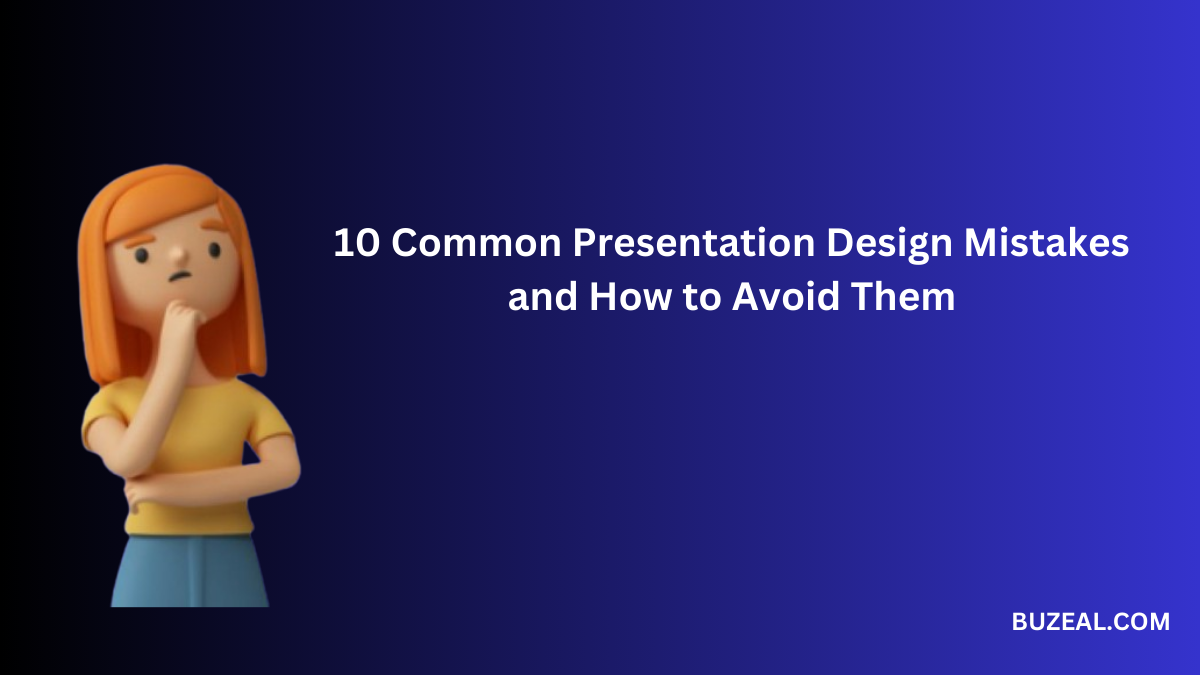
Imagine sitting through a presentation with tiny, unreadable text, clashing colours, and no clear message – irritating, right?
Whether you’re offering to colleagues, clients, or traders, a poorly designed presentation can go away an enduring bad impact. But with a few easy tweaks, you may create attractive slides that seize your target audience’s attention.
Let’s explore the best presentation design errors and the way to avoid them to make your work stand out.
(Hint: If you are suffering, remember looking for assist from professional presentation layout offerings.)
1. Overloading Slides with Text
Mistake: Packing slides with too much text makes them difficult to read and overwhelming for the audience. Instead of taking note of you, viewers is probably busy trying to study the whole thing.
Solution: Use bullet points or short sentences. Stick to the “6×6 rule”: six words in keeping with line, six traces in step with slide. This keeps your slides smooth and your message clear. Remember, slides ought to support your talk, now not replace it.
2. Poor Colour Choices
Mistake: Using clashing or overly vivid colours can make slides tough to study and distract from the message.
Solution: Stick to a cohesive shade palette. Use excessive-contrast colorations for text and background to ensure clarity.
For example, dark textual content on a light historical past or vice versa works nicely. Avoid overly vibrant sun shades that pressure the eyes.
3. Tiny or Hard-to-Read Fonts
Mistake: Fonts that are too small or in ornamental patterns can make your content illegible, especially for people behind the room.
Solution: Use sans-serif fonts like Arial, Calibri, or Helvetica for smooth and professional slides. Keep font sizes above 24 factors for frame textual content or even large for headings. This guarantees every person can observe alongside without difficulty.
4. Lack of Visual Balance
Mistake: Slides that look either cluttered or empty fail to engage the target market. Too many factors can weigh down, even as too few may additionally appear incomplete.
Solution: Create visual balance by spacing out elements lightly. Use consistent margins and align textual content and visuals properly. Include sufficient white space to avoid muddle, making your slides easy to study and visually attractive.
5. Ignoring Visual Hierarchy
Mistake: Without clear visible hierarchy, your audience won’t know where to focus.
Solution: Use size, shade, or ambitious textual content to highlight critical factors. Place the maximum important statistics on the top of the slide. Use headings, subheadings, and bullet factors to guide your audience via your content.
6. Using Poor-Quality Images
Mistake: Blurry, stretched, or irrelevant images make your presentation look unprofessional.
Solution: Always use excessive-decision pics which can be relevant for your subject matter. Websites like Unsplash or Pexels offer loose, super pics. Avoid overused inventory snap shots and choose visuals that add cost on your slides.
7. Overusing Transitions and Animations
Mistake: Excessive animations or transitions can distract instead of beautify the presentation.
Solution: Keep it simple. Use subtle animations, like fade-ins, sparingly to draw interest to key points. Avoid flashy consequences like spinning textual content or bouncing photos, which can seem unprofessional.
8. Forgetting About Accessibility
Mistake: Ignoring font colors, sizes, or contrasts could make your slides inaccessible to human beings with visible impairments.
Solution: Design with accessibility in mind. Test your slides for readability the usage of gear like shade contrast checkers. Stick to available font styles and sizes. Ensure your presentation may be understood by absolutely everyone in your audience.
9. Neglecting Consistency
Mistake: Changing fonts, shades, or layouts throughout slides confuses visitors and makes your presentation look unorganised.
Solution: Use a constant template or subject matter throughout your presentation. Stick to the same font fashion, shade palette, and format to create a cohesive appearance. Templates from PowerPoint or Canva can help preserve consistency.
10. Lack of a Clear Call to Action
Mistake: Ending without a clear next step leaves your audience unsure of what to do.
Solution: Conclude with a strong call to action (CTA). Whether it’s to contact you, visit your website, or implement your suggestions, make it clear and compelling.
For example: “Email us today to learn more about our presentation design services.”
FAQs
1. Why is font size important in presentations?
Using large, readable fonts ensures everyone in the audience can follow your points without straining their eyes. It also helps convey professionalism and clarity.
2. How many slides should a presentation have?
The number depends on your topic, but aim for around one slide per minute of your talk to keep things concise and engaging.
3. What’s the best way to incorporate visuals?
Use charts, graphs, and images to support your message. Ensure visuals are high-quality and don’t overcrowd your slides.
4. Should I use animations in my presentation?
Animations can be helpful for emphasising points, but use them moderately. Subtle effects like fade-ins are effective without being distracting.
5. How can presentation design services help me?
Experts in presentation design services can transform your content into polished, visually appealing slides, ensuring clarity, professionalism, and audience engagement.
